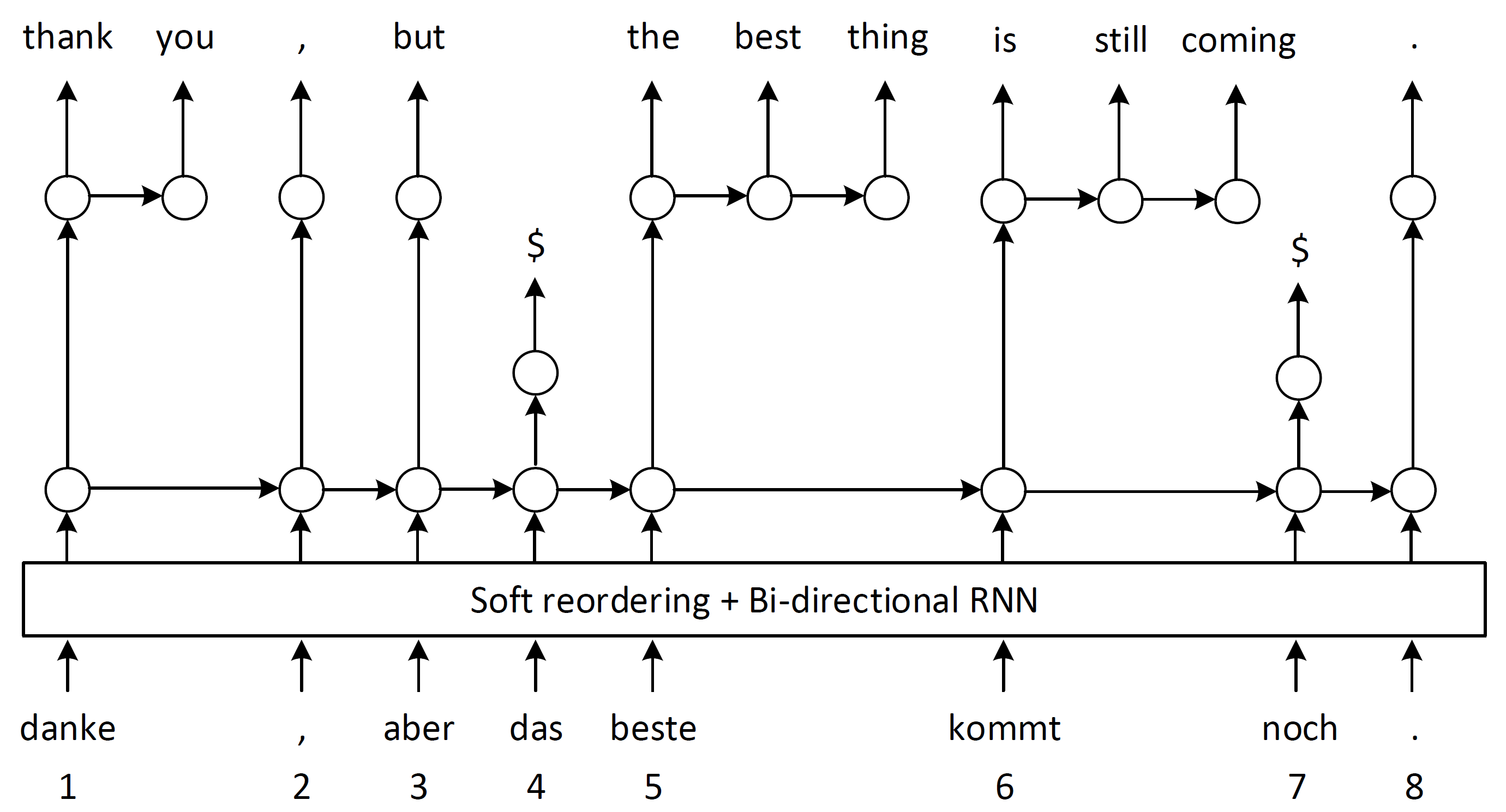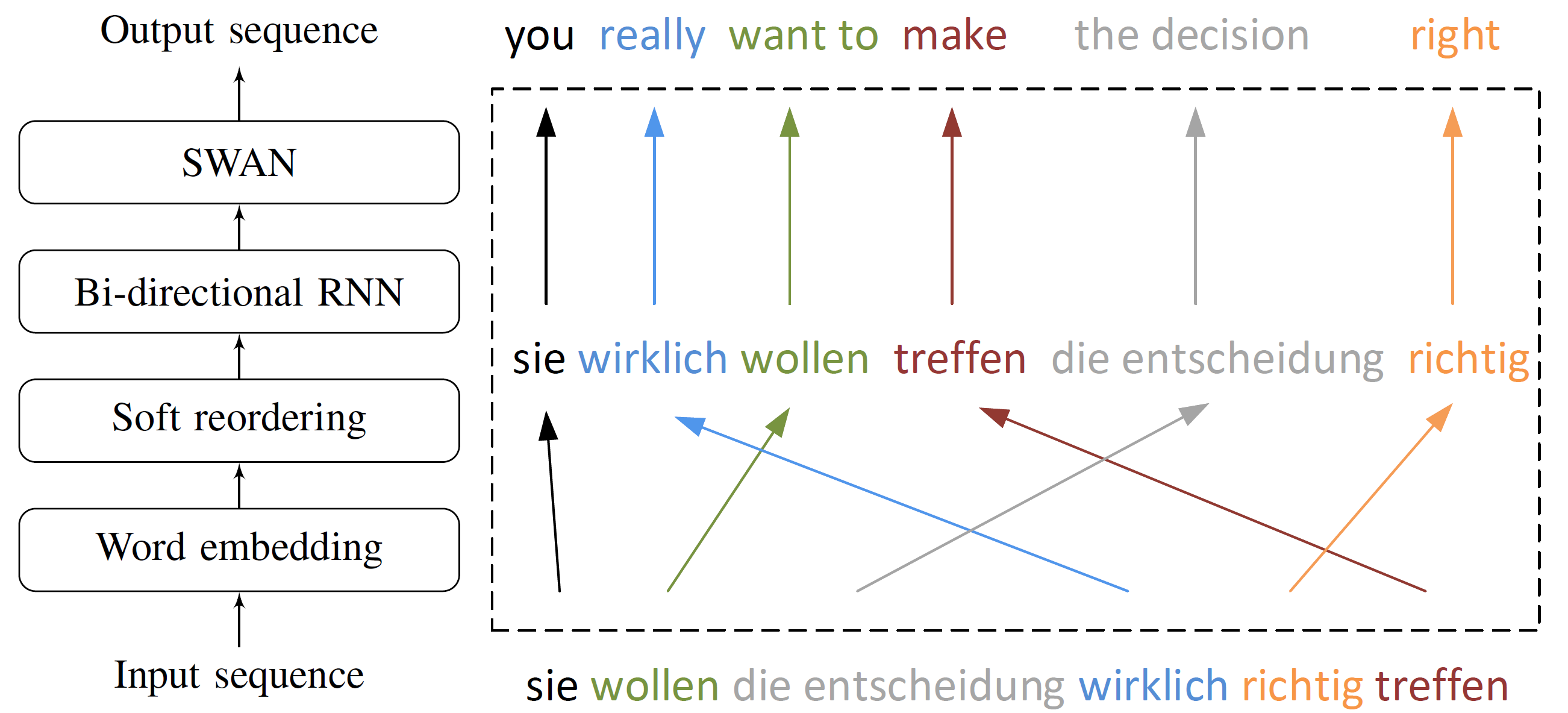This is NPMT, the source codes of Towards Neural Phrase-based Machine Translation and Sequence Modeling via Segmentations from Microsoft Research. It is built on top of the fairseq toolkit in Torch. We present the setup and Neural Machine Translation (NMT) experiments in Towards Neural Phrase-based Machine Translation.
Neural Phrase-based Machine Translation (NPMT) explicitly models the phrase structures in output sequences using Sleep-WAke Networks (SWAN), a recently proposed segmentation-based sequence modeling method. To mitigate the monotonic alignment requirement of SWAN, we introduce a new layer to perform (soft) local reordering of input sequences. Different from existing neural machine translation (NMT) approaches, NPMT does not use attention-based decoding mechanisms. Instead, it directly outputs phrases in a sequential order and can decode in linear time.
An illustration of using NPMT in German-English translation

Please refer to the PR for our implementations. Our implementation is based on the lastest version of fairseq.
If you use the code in your paper, then please cite it as:
@article{pshuang2018NPMT,
author = {Po{-}Sen Huang and
Chong Wang and
Sitao Huang and
Dengyong Zhou and
Li Deng},
title = {Towards Neural Phrase-based Machine Translation},
journal = {CoRR},
volume = {abs/1706.05565},
year = {2017},
url = {http://arxiv.org/abs/1706.05565},
archivePrefix = {arXiv},
eprint = {1706.05565},
}
and
@inproceedings{wang2017SWAN,
author = {Chong Wang and
Yining Wang and
Po{-}Sen Huang and
Abdelrahman Mohamed and
Dengyong Zhou and
Li Deng},
title = {Sequence Modeling via Segmentations},
booktitle = {Proceedings of the 34th International Conference on Machine Learning,
{ICML} 2017, Sydney, NSW, Australia, 6-11 August 2017},
pages = {3674--3683},
year = {2017},
}
- A computer running macOS or Linux
- For training new models, you'll also need a NVIDIA GPU and NCCL
- A Torch installation. For maximum speed, we recommend using LuaJIT and Intel MKL.
- A recent version nn. The minimum required version is from May 5th, 2017. A simple
luarocks install nnis sufficient to update your locally installed version.
Install fairseq by cloning the GitHub repository and running
luarocks make rocks/fairseq-scm-1.rockspec
LuaRocks will fetch and build any additional dependencies that may be missing. In order to install the CPU-only version (which is only useful for translating new data with an existing model), do
luarocks make rocks/fairseq-cpu-scm-1.rockspec
The LuaRocks installation provides a command-line tool that includes the following functionality:
fairseq preprocess: Data pre-processing: build vocabularies and binarize training datafairseq train: Train a new model on one or multiple GPUsfairseq generate: Translate pre-processed data with a trained modelfairseq generate-lines: Translate raw text with a trained modelfairseq score: BLEU scoring of generated translations against reference translationsfairseq tofloat: Convert a trained model to a CPU modelfairseq optimize-fconv: Optimize a fully convolutional model for generation. This can also be achieved by passing the-fconvfastflag to the generation scripts.
The fairseq source distribution contains an example pre-processing script for the IWSLT14 German-English corpus. Pre-process and binarize the data as follows:
$ cd data/
$ bash prepare-iwslt14.sh
$ cd ..
$ TEXT=data/iwslt14.tokenized.de-en
$ fairseq preprocess -sourcelang de -targetlang en \
-trainpref $TEXT/train -validpref $TEXT/valid -testpref $TEXT/test \
-thresholdsrc 3 -thresholdtgt 3 -destdir data-bin/iwslt14.tokenized.de-en
This will write binarized data that can be used for model training to data-bin/iwslt14.tokenized.de-en.
We also provide an example of pre-processing script for the IWSLT15 English-Vietnamese corpus. Pre-process and binarize the data as follows:
$ cd data/
$ bash prepare-iwslt15.sh
$ cd ..
$ TEXT=data/iwslt15
$ fairseq preprocess -sourcelang en -targetlang vi \
-trainpref $TEXT/train -validpref $TEXT/tst2012 -testpref $TEXT/tst2013 \
-thresholdsrc 5 -thresholdtgt 5 -destdir data-bin/iwslt15.tokenized.en-vi
Use fairseq train to train a new model.
Here a few example settings that work well for the IWSLT14, IWSLT15 datasets:
# NPMT model (IWSLT DE-EN)
$ mkdir -p trainings/iwslt_de_en
$ fairseq train -sourcelang de -targetlang en -datadir data-bin/iwslt14.tokenized.de-en \
-model npmt -nhid 256 -dec_unit_size 512 -dropout .5 dropout_hid 0 -npmt_dropout .5 \
-optim adam -lr 0.001 -batchsize 32 -log_interval 100 nlayer 2 -nenclayer 2 -kwidth 7 \
-max_segment_len 6 -rnn_mode GRU -group_size 500 -use_resnet_enc -use_resnet_dec -log
-momentum 0.99 -clip 10 -maxbatch 600 -bptt 0 -maxepoch 100 -ndatathreads 4 -seed 1002
-maxsourcelen 75 -num_lower_win_layers 1 -save_interval 250 -use_accel -noearlystop \
-validbleu -lrshrink 1.25 -minepochtoanneal 18 -annealing_type slow \
-savedir trainings/iwslt_de_en
# NPMT model (IWSLT EN-DE)
$ mkdir -p trainings/iwslt_en_de
$ fairseq train -sourcelang en -targetlang de -datadir data-bin/iwslt14.tokenized.en-de \
-model npmt -nhid 256 -dec_unit_size 512 -dropout .5 -dropout_hid 0 -npmt_dropout .5 \
-optim adam -lr 0.001 -batchsize 32 -log_interval 100 -nlayer 2 -nenclayer 2 -kwidth 7 \
-max_segment_len 6 -rnn_mode GRU -group_size 500 -use_resnet_enc -use_resnet_dec \
-log -momentum 0.99 -clip 10 -maxbatch 800 -bptt 0 -maxepoch 100 -ndatathreads 4 \
-seed 1002 -maxsourcelen 75 -num_lower_win_layers 1 -save_interval 250 -use_accel \
-noearlystop -validbleu -lrshrink 1.25 -minepochtoanneal 15 \
-annealing_type slow -savedir trainings/iwslt_en_de
# NPMT model (IWSLT EN-VI)
$ mkdir -p trainings/iwslt_en_vi
$ fairseq train -sourcelang en -targetlang vi -datadir data-bin/iwslt15.tokenized.en-vi \
-model npmt -nhid 512 -dec_unit_size 512 -dropout .4 -dropout_hid 0 -npmt_dropout .4 \
-optim adam -lr 0.001 -batchsize 48 -log_interval 100 -nlayer 3 -nenclayer 2 -kwidth 7 \
-max_segment_len 7 -rnn_mode LSTM -group_size 800 -use_resnet_enc -use_resnet_dec -log \
-momentum 0.99 -clip 500 -maxbatch 800 -bptt 0 -maxepoch 50 -ndatathreads 4 -seed 1002 \
-maxsourcelen 75 -num_lower_win_layers 1 -save_interval 250 -use_accel -noearlystop \
-validbleu -nembed 512 -lrshrink 1.25 -minepochtoanneal 8 -annealing_type slow \
-savedir trainings/iwslt_en_vi
By default, fairseq train will use all available GPUs on your machine.
Use the CUDA_VISIBLE_DEVICES environment variable to select specific GPUs or -ngpus to change the number of GPU devices that will be used.
Once your model is trained, you can translate with it using fairseq generate (for binarized data) or fairseq generate-lines (for text).
Here, we'll do it for a NPMT model:
# Translate some text
$ DATA=data-bin/iwslt14.tokenized.de-en
$ fairseq generate-lines -sourcedict $DATA/dict.de.th7 -targetdict $DATA/dict.en.th7 \
-path trainings/iwslt_de_en/model_bestbleu.th7 -beam 1 -model npmt
| [target] Dictionary: 22823 types
| [source] Dictionary: 32010 types
> danke , aber das beste kommt noch .
max decoding: | 1:184 1:15| 2:4| 3:28| 4:6 4:282| 6:16 6:201 6:311| 8:5|
avg. phrase size 1.666667
S danke , aber das beste kommt noch . <pad>
O danke , aber das beste kommt noch .
H -0.10934638977051 thank you , but the best is still coming .
A 1
where the max decoding suggests the output segments are | thank you | , | but | the best | is still coming | . |, and avg. phrase size represents the average phrase length 10/6 = 1.666667.
Generation with the binarized test sets can be run as follows (not in batched mode), e.g. for German-English:
$ fairseq generate -sourcelang de -targetlang en -datadir data-bin/iwslt14.tokenized.de-en \
-path trainings/iwslt_de_en/model_bestbleu.th7 -beam 10 -lenpen 1 -dataset test -model npmt | tee /tmp/gen.out
...
| Translated 6750 sentences (137891 tokens) in 3013.7s (45.75 tokens/s)
| Timings: setup 10.7s (0.4%), encoder 28.2s (0.9%), decoder 2747.9s (91.2%), search_results 0.0s (0.0%), search_prune 0.0s (0.0%)
| BLEU4 = 29.92, 64.7/37.9/23.8/15.3 (BP=0.973, ratio=1.027, sys_len=127660, ref_len=131141)
# Word-level BLEU scoring:
$ grep ^H /tmp/gen.out | cut -f3- | sed 's/@@ //g' > /tmp/gen.out.sys
$ grep ^T /tmp/gen.out | cut -f2- | sed 's/@@ //g' > /tmp/gen.out.ref
$ fairseq score -sys /tmp/gen.out.sys -ref /tmp/gen.out.ref
BLEU4 = 29.92, 64.7/37.9/23.8/15.3 (BP=0.973, ratio=1.027, sys_len=127660, ref_len=131141)
fairseq is BSD-licensed. The released codes modified the original fairseq are BSD-licensed. The rest of the codes are MIT-licensed.
